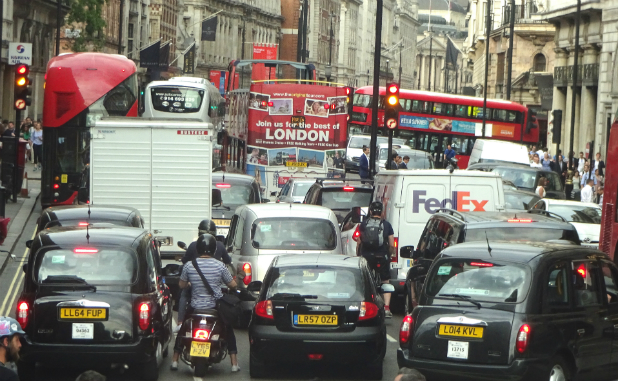
As the UK aims to reduce its air pollution, the government has introduced Clean Air Zones (CAZ) to restrict high-emission vehicles’ movement in cities. In this article, we will explain what these zones are, where they are implemented, and how they work.
What is CAZ?
CAZ stands for Clean Air Zones. The UK has introduced CAZ to combat emissions caused by polluting vehicles and improve air quality. The zone could be applied to a single street or an area of a city. Vehicles that do not comply with the emissions standard are found using number plate cameras.
How does CAZ work?
There are four different CAZ classes:
- Class A applies to buses, coaches, taxis and private hire vehicles (PHVs)
- Class B covers buses, coaches, taxis, PHVs and heavy goods vehicles (HGVs)
- Class C is applicable to buses, coaches, taxis, PHVs, HGVs and light goods vehicles (LGVs)
- Class D is for buses, coaches, taxis, PHVs, HGVs, LGVs and cars.
Depending on the class that is applied to the CAZ, certain vehicles will be restricted from driving in the zone. The restrictions relate to how much pollution is caused by certain vehicles, which is based on European emissions standards. Anyone driving a vehicle with emissions standards that do not conform to the area will have to pay a fine.
However, there are some vehicles that are exempt from the charge – regardless of their emissions standard – and this will be decided by the local authority. These exemptions could include historic vehicles, the vehicles of residents and vehicles with disabled passenger tax.
Local authorities are responsible for deciding and implementing the restrictions for their zones. Some CAZ will have a charge for the non-compliant vehicles that drive in the zone, while others will not. Charges can range from £8 to £1,000.
The prices to drive in a CAZ can vary depending on your vehicle or which zone you enter. Local authorities, however, are only able to charge a fee to cover the expenses of the scheme, and not make additional revenue. The government offers an online tool to inform you of the charges you could face – you just have to enter your number plate and state if the vehicle is registered in the UK or not.
What are the European emission standards?
The European emissions standards refer to how much carbon emissions are produced by a vehicle. The European Union has been regulating vehicles and setting emissions standards since 1992. The Euro 1 standard was introduced in this year, and it became a legal requirement to install catalytic converters on all new cars. Since 1992, more bands have been introduced to the emissions standards. There are currently six categories a vehicle can fall into. The most recent, Euro 6, was introduced in September 2014.
The standards aim to reduce the amount of nitrogen oxides (NOx), carbon monoxide (CO), hydrocarbons (HC) and particulate matter (PM) produced by vehicles that pollute the air.
Buses, coaches and HGVs that meet Euro 6 emissions standards are exempt from CAZ restrictions. Diesel cars, vans and taxis that meet Euro 6 or petrol cars, vans and taxis that meet Euro 4 emissions standards are also exempt.
What is the difference between CAZ, ULEZ and LEZ?
While CAZ stands for Clean Air Zones and LEZ stands for Lower Emission Zones, they essentially are different names for the same thing. ULEZ refers to Ultra Low Emission Zone, which has stricter charging policies.
There is one ULEZ in the UK, located within London’s wider LEZ. Both zones aim to combat air pollution in the capital city – which has the poorest air quality in the country. Almost two-thirds of Londoners changed their usual mode of transport due to the ULEZ.

The LEZ was established in 2008 and covers most of Greater London to encourage vehicles that don’t meet LEZ emission standards to become cleaner. While most of Greater London is covered within the zone, there are some diversionary routes not covered by LEZ.
London’s LEZ operates 24 hours a day, seven days a week, and if your vehicle doesn’t meet its guidelines you will be charged – more information on this can be found here. As LEZ operates from midnight to midnight, if you park a car within the LEZ for 10 minutes from 23:55 until 00:05, you will be charged twice.
There are some vehicles that are exempt for the LEZ restrictions, such as:
- Specialist vehicles designed and built for off-road use, but may use the road for limited purposes (including agricultural and forestry tractors, mowing machines, agricultural and farm machinery and equipment, mobile cranes and road and building construction machinery)
- Vehicles built before 1 January 1973
- Vehicles with historic tax class
- Vehicles operated by the Ministry of Defence.
The ULEZ is located in central London, covering the City of London, Westminster, Mayfair, Soho, Bloomsbury, Clerkenwell and Waterloo – the same area as the congestion charge. The zone was introduced in April 2019, and similarly to the LEZ operates from midnight to midnight, seven days a week – excluding Christmas Day. However, for the ULEZ, most vehicles must meet restrictions, including cars, motorcycles and mopeds. All electric vehicles are exempt from the penalty, as they emit zero emissions.
The charge for utilising the ULEZ is £12.50 for cars, smaller vans, motorbikes and other lighter vehicles and £100 for lorries, buses, coaches and other heavier vehicles.
For more information read our in-depth guide about the ULEZ.
Where are the Clean Air Zones in the UK?
Aberdeen, Bath, Birmingham, Bristol, Dundee, Edinburgh, Glasgow, Greater Manchester, Leeds, Leicester and Sheffield all have plans in place to introduce their CAZ. It is the cities’ local authorities that will be responsible for introducing the zones – each authority outlined their plans to the government in March 2018. Some of the plans for zones have been paused or delayed due to the Covid-19 pandemic, which may affect when they are introduced.
There is also the LEZ and ULEZ in London.
Aberdeen
Scotland has used the term Low Emission Zone (LEZ) for all of its vehicle-restricting areas. The zone, which is expected to be located in the city centre, should come into effect in late 2020, affecting cars and heavy diesel vehicles. Vehicles that do not comply with the standards will be unable to enter the zone.
Aberdeen City Council suggests that vehicle must be:
- Euro 6 for diesel cars (cars registered from September 2015)
- Euro 4 for petrol cars (cars registered from January 2006)
- Euro 6 for heavy diesel vehicles (including older retrofitted engines which would be improved to operate as Euro 6).
Bath
Bath’s CAZ, dubbed Bath Breathes, was initially planned for November 2020, but has been postponed until at least January 2021. The CAZ will be a Class C zone, which means that cars and motorbikes will be exempt – however, both taxis and PHVs could face the penalty.
Bath Breathes may also reduce traffic into Queen Square, which could enable private cars to be exempt from charges. The city aims to reduce its nitrogen dioxide (NO2) levels, and has further plans to encourage a shift to cleaner travel and transport.
Birmingham
The Birmingham CAZ, planned for 2020, will see all roads within the A4540 Middleway Ring Road, excluding the Middleway, covered by the zone 24 hours a day, seven days a week. Find the Birmingham Clean Air Zone map here. The fee will be applied on a 24-hour basis – once in the zone, vehicles can drive around without limit for the remainder of this period.
The vehicle criteria are as follows:
- Euro 6 for diesel vehicles (cars registered from September 2015)
- Euro 4 for petrol vehicles, or LPG added to original petrol engine (cars registered from January 2006)
- Euro 6 for gas vehicles
- Fully electric or hydrogen fuel cell
- Hybrid electric – the diesel/petrol engine must meet the relevant criteria above.
The charge is set for £8 per day for cars, taxis (hackney carriages and private hire), LGVs and minibuses, and £50 for HGVs, coaches, buses.
Bristol
Clean Air for Bristol is set to launch in March 2021. Bristol plans to introduce two zones – a medium-sized CAZ targeting buses, lorries and taxis, and a smaller zone within this that bans private diesel vehicles. Both zones will operate between 7am and 3pm every day.
The local authority has made changes to the zone’s boundaries, accommodating for diesel cars to travel from A370 to A4 and enter Cabot Circus, as well as removing plans for weight restrictions on Marlborough Street and Upper Maudlin Street. However, the city is yet to release its final boundaries outline or penalty charges.
Dundee
Dundee’s LEZ is set for the inner ring road and could affect all HGVs, LGVs and diesel cars registered on or before 31 August 2015 and all petrol cars registered before 2006.
Edinburgh
Due to be introduced at the end of 2020, but with a grace period, Edinburgh’s LEZ plans are still under consultation. However, all of Scotland’s LEZ plans have been paused due to the Covid-19 pandemic.
Glasgow
Glasgow introduced a LEZ on 31 December 2018, applying only to local service buses. However, the city plans to extend the LEZ to all vehicle types from 31 December 2022.
Greater Manchester
Greater Manchester has proposed a Class C Caz for 2021. The zone would be in operation for 24 hours a day, seven days a week. The Greater Manchester Clean Air Zone could cover Wigan, Bolton, Bury, Rochdale, Oldham, Tameside, Stockport, Trafford, Salford and Manchester – the exact boundary has not yet been finalised. Motorways and some main trunk roads managed by Highways England would be exempt.
The proposed daily charges for the non-compliant commercial vehicles are:
- £7.50 for taxis and private hire vehicles (from 2022)
- £100 for Buses, coaches and HGVs (from 2022)
- £7.50 for LGVs such as vans and minibuses (from 2023).
If a driver does not comply, a Penalty Charge Notice (PCN) of £120 will be issued and must be paid in addition to the outstanding daily charge.
Leeds
Plans for Leeds’ Class B LEZ were set for 6 January 2020, but these plans have been postponed until January 2021 at the earliest. For vehicles that do not meet the emissions standards, taxis, private hire vehicles and minibuses will pay a charge of £12.50, and HGVs, buses, coaches will have to pay £50. Vehicles will be identified with a central government vehicle checker via a network of more than a hundred cameras. The zone will be effective 24 hours a day, every day of the year.
Find the Leeds Clean Air Zone map here.
Leicester
For 2021, the city of Leicester plans to introduce a small CAZ that will affect taxis, buses and coaches. Non-compliant taxis will be charged £8, while buses and coaches will face a penalty of £50.
Sheffield
Sheffield’s CAZ, planned for early 2021, will cover the inner ring road and the city centre, including Park Square and the A61/Parkway junction.
Sheffield City Council states that vehicles must be:
- Euro 6 for diesel buses and coaches
- Euro 6 for diesel HGVs
- Euro 6 for diesel LGVs and minibuses
- Euro 4 for petrol LGVs and minibuses
- Taxis which are ultra-low emissions (hybrid, electric and hydrogen fuel cell) or Liquid Petroleum Gas (LPG).
A penalty of £10 per day will be set for restricted LGVs and taxis, and £50 per day for restricted coaches, buses and HGVs.
Need insurance for your motorbike?
If you have a motorbike and need insurance, learn more about Bikesure’s cheap, specialist cover for riders.
Additional reading
Your complete guide to electric motorcycles in 2020 and beyond
How can I use my motorcycle during the coronavirus lockdown?





